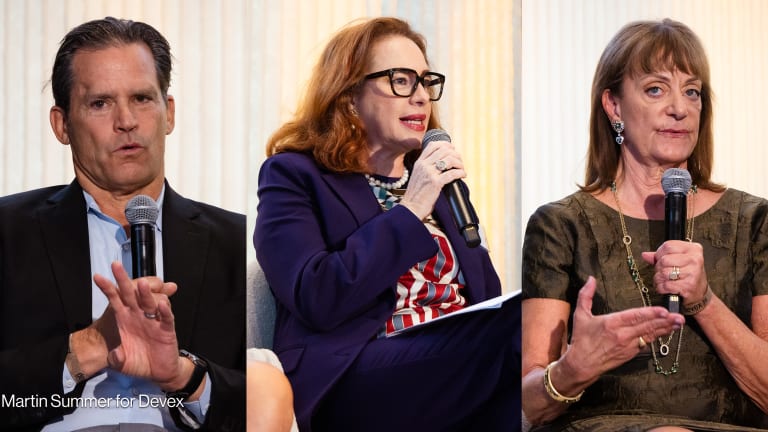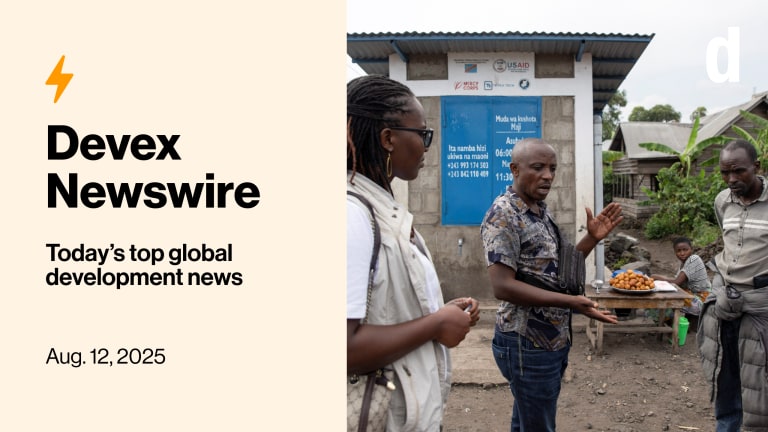
Mission directors at the U.S. Agency for International Development are tasked with translating a list of directives from headquarters into actionable programs on the ground.
Under the USAID Forward agenda, public-private partnerships have taken center stage in speeches and a profusion of new agreements to partner with some of the world’s largest businesses — including a recent memorandum of understanding with Wal-Mart — while the actual percentage of mission funding going to PPPs remains relatively small.
The agency has set hard targets for private sector engagement: 10 percent of mission funds should go to “PPPs with a minimum of one-to-one leverage by 2015.” According to the 2013 USAID Forward progress report, that number currently sits at 1.7 percent.
Devex spoke with Chris Jurgens, director of USAID’s Global Partnerships Division, to learn more about how the agency initiates and navigates relationships with international companies through an assortment of global MOUs, relationship managers and high-level contacts, and what efforts are underway at headquarters to pull more of USAID’s mission directors into the PPP arena.
Here are some excerpts from our conversation with Jurgens:
What was the process of building this partnership with Wal-Mart, and what specific goals are global MoUs designed to achieve?
Our objective is to have a strategic partnership with these corporate partners — like Wal-Mart — to holistically identify what are [their] core business and sustainability objectives, where do they overlap with our priorities in a given country context or sectoral context, and how can we use an MoU as a framework to articulate those intersections and how we want to take them forward. It’s a joint commitment to collaborate, and the MoU provides a framework for that collaboration in terms of areas of common interest or ways we might work together and channel our joint resources. And then it provides some guidance as to how we want to manage the relationship on an ongoing basis between USAID and the companies.
Wal-Mart has proactively reached out to us and had an interest in working with us as their expansion in Africa is new for them. Working with smallholder farmers and doing skills training in Africa is not something they have a long pedigree of doing. So there’s a mutual interest in growing our relationship based on what we can bring to the other side.
[They are] also a company into which we’ve introduced this new approach to relationship management, so that we have a central relationship manager between USAID and Wal-Mart, recognizing that our interests now span multiple sectors and multiple geographies. We align in the area of food security, but we also align in areas of workforce training.
How are you working to coordinate with the missions to ensure they are aware of the opportunities that may be available with the private sector partners you’ve brought on board through a global MoU or another partnership mechanism?
We’ve identified 35 companies where we have a strong track record of collaboration in the past and a desire to broaden that collaboration, or they’re a newer partner but offer really high potential to work together even if we’re in early stages of a relationship. Those are 35 relationships where we’re really making an effort to pull together everything we’ve done with this company across the board, particularly those like Wal-Mart or [information and communications technology] companies where we work with them across multiple sectors. In the past we didn’t have in all cases an agency-wide view of that.
Then [we] have a single point of contact in the agency, so that anybody from the mission who says, “I want to understand how we’ve worked with Wal-Mart or Cisco or Coke in the past” knows who to turn to. We have internet content that has things like our global MoUs posted and other project related documentation so people can get a sense of that.
There’s a point of contact that can provide them coaching on, this is how you approach Wal-Mart or talk to them in their language. These are their goals, and if you want to engage them this is the language and the approach that’s going to resonate most with them. Do they like to talk about broad frameworks, or do they immediately like to get down into what’s a specific, tangible transaction we can work together… those relationship managers can be proactive and through the communications channels we have either celebrate what a particular mission has done with a corporate partner and raise awareness.
The fact that we now have an agency-wide coordinated approach to these top 35 corporate partners, often bolstered by a global MOU, is what’s enabling us to be more proactive and — from a Washington perspective — provide better service and support to the field as they explore these relationships.
What would you say is the balance between pushing partnerships from your office and from headquarters in Washington versus a pull of demand for more partnerships from USAID’s missions and mission directors?
It’s healthy on both sides. There’s a lot of pull from the missions. All of our missions have goals set around private sector engagement and building public-private partnerships into their programmatic portfolio. There’s both an embrace of working with the private sector as being core to where we want to take the agency under the administrator’s new model of development and figuring out how we can partner with the private sector for more market based solutions — solutions that are sustainable, long-term … There’s that belief in that’s a good way to do development.
We have concrete tangible targets for missions to do more in this space … There just increasingly seeing at a number of missions as well that our resources are dwindling compared to the resources the private sector is bringing to the table, particularly in countries that are on a rapid trajectory towards middle-income status … so there’s a lot of pull from their side.
The challenge is more where we engage in the program cycle and lining up private sector timescales with public sector timescales. At USAID, we’re often programming our work one or two years or more out based on our funding cycles and the planning cycles that are required on our side for the agency and for Congress, and the key for our side is being able to engage early with the private sector when we’re just starting to formulate our programs. As our missions start to go through their country strategy development and their program design and they’re identifying — here are core development outcomes in health or food security or climate change and engaging the private sector then so there’s really opportunity for co-creation.
What we often hear from missions is it’s much harder to build partnerships when programs are already fully-baked, because there’s not always the flexibility to do that. We do have windows and mechanisms that offer more flexibility, but that’s key. Sometimes, where it’s more challenging is when the private sector has a short term opportunity that they want to move on tomorrow. The mission may see an alignment of interest, but may not have flexibility to respond to that [and] there’s a lot of demand from the field to want to do more of these.
Read more development aid news online, and subscribe to The Development Newswire to receive top international development headlines from the world’s leading donors, news sources and opinion leaders — emailed to you FREE every business day.








